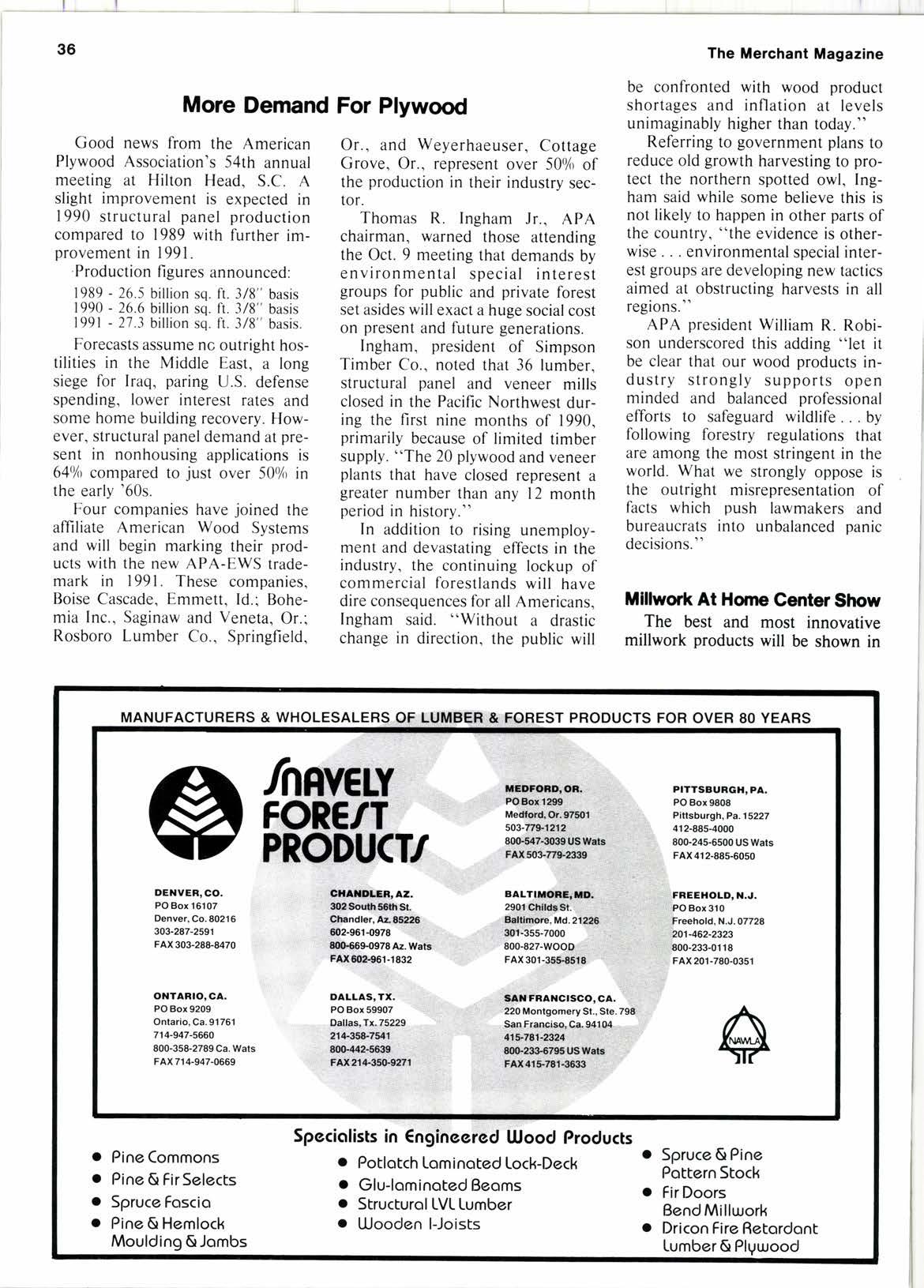
9 minute read
More Demand For Plywood
Good news from the American Plywood Association's 54th annual meeting at Hilton Head, S.C. A slight improvement is expected in 1990 structural panel production compared to 1989 with further improvement in 1991.
.Production figures announced:
1989 - 26.5 billion sq. ft. l/8" basis
1990 - 26.6 billion sq. ft. 3/8" basis
1991 - 21.3 billion sq. ft. 3/8" basis.
Forecasts assume nc outright hostilities in the Middle East, a long siege for Iraq, paring U.S. defense spending, lower interest rates and some home building recovery. However, structural panel demand at present in nonhousing applications is 640ft compared to just over 50% in the early '60s.
Four companies have joined the affiliate American Wood Systems and will begin marking their products with the new APA-EWS trademark in 199 I . These companies. Boise Cascade, Emmett, Id.; Bohemia Inc., Saginaw and Veneta, Or.; Rosboro Lumber Co., Springfield,
Or., and Weyerhaeuser, Cottage Grove, Or., represent over 50oA of the production in their industry sector.
Thomas R. Ingham Jr., APA chairman, warned those attending the Oct. 9 meeting that demands by environmental special interest groups for public and private forest set asides will exact a huge social cost on present and future generations.
Ingham, president of Simpson Timber Co., noted that 36 lumber. structural panel and veneer mills closed in the Pacific Northwest during the first nine months of 1990, primarily because of limited timber supply. "The 20 plywood and veneer plants that have closed represent a greater number than any l2 month period in history."
In addition to rising unemployment and devastating effects in the industry, the continuing lockup of commercial forestlands will have dire consequences for all Americans. Ingham said. "Without a drastic change in direction, the public will be confronted with wood product shortages and inflation at levels unimaginably higher than today."
Referring to government plans to reduce old growth harvesting to protect the northern spotted owl, Ingham said while some believe this is not likely to happen in other parts of the country, "the evidence is otherwise. environmental special interest groups are developing new tactics aimed at obstructing harvests in all regions. "
APA president William R. Robison underscored this adding "let it be clear that our wood products industrystrongly supports open minded and balanced professional efforts to safeguard wildlife by following forestry regulations that are among the most stringent in the world. What we strongly oppose is the outright misrepresentation of facts which push lawmakers and bureaucrats into unbalanced panic decisions."
Ullhrork At Home Genter Show
The best and most innovative millwork products will be shown in
"The Showcase of Profit in Windows. Doors & Millwork" at the l99l National Home Center Show, March 24-26 at McCormick Place. Chicago, Il.
Coordinated by the National Sash & Door Jobbers Association, the display will be adjacent to their information center for home improvement dealers.
Design Purchase Option
The Weyerhaeuser DesignCenter will now be available for purchase instead of the current lease arrangement.
"Customers want to purchase the DesignCenter. Wenow have a package that has more design capability and speed than anyone, the most comprehensive training and support, and proven performance all at a very attractive price," said Bob Revell, general manager for the DesignCenter program at Weyerhaeuser Co., Tacoma, Wa.
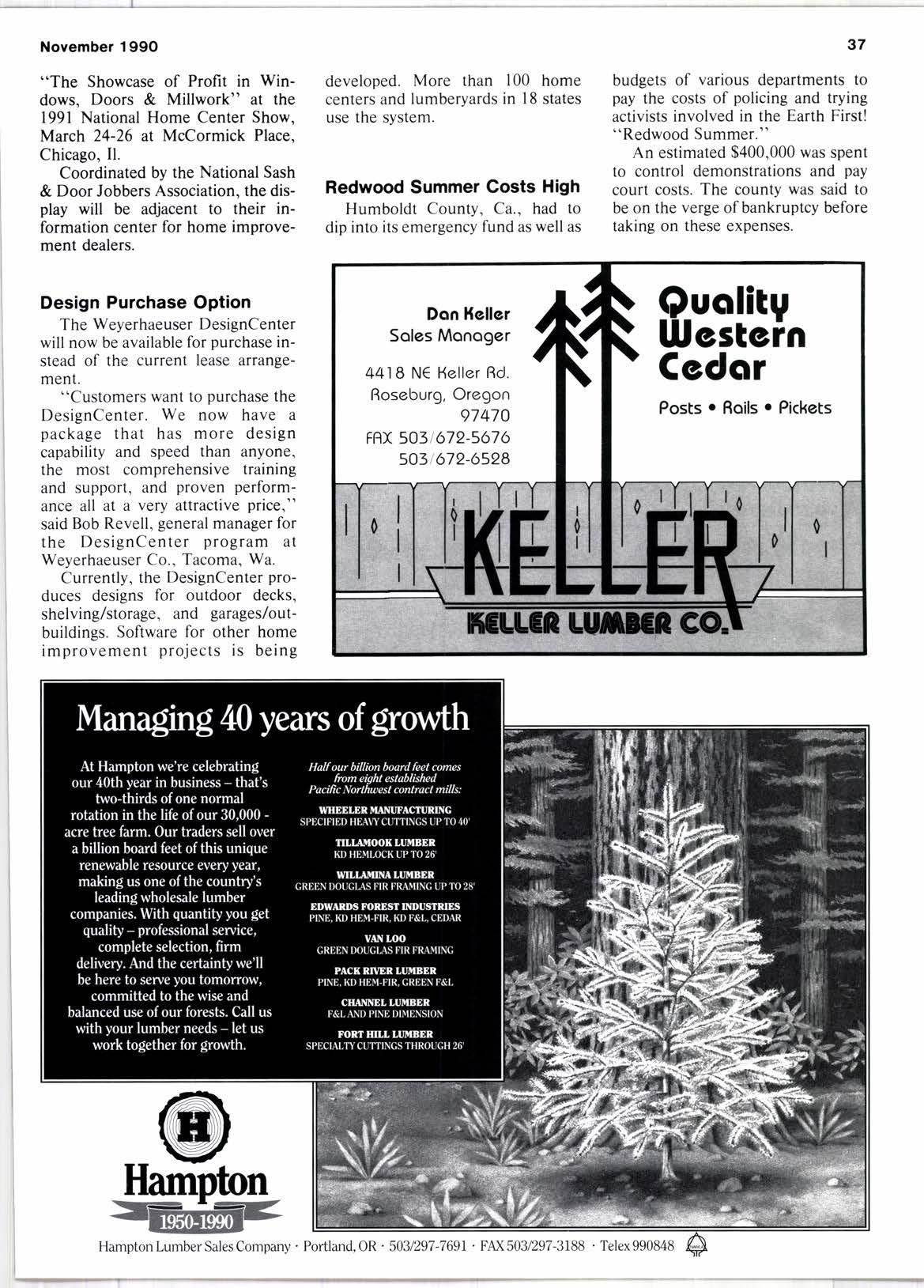
Currently, the DesignCenter produces designs for outdoor decks, shelving/storage, and garages/outbuildings. Software for other home improvement projects is being developed. More than 100 home centers and lumberyards in l8 states use the system.
Redwood Summer Costs High Humboldt County, Ca., had to dip into its emergency fund as well as budgets of various departments to pay the costs of policing and trying activists involved in the Earth First! "Redwood Summer."
An estimated $400,000 was spent to control demonstrations and pay court costs. The county was said to be on the verge ofbankruptcy before taking on these expenses.
44.|B N€ Heller Rd. Rosoburg, Oregon 97470
FAX 5031672-5676 5031672-6528
Cal State Expansion
Cal State Forest Products. an Anaheim, Ca., wholesale firm, is expanding,opening a Northern California sales oflice.
John Turner, one of the partners
Softrvood Consumptkn Dropo
U.S. softwood lumber consumption will be in seasonal and cyclical retreat for the next five months. according to Resource Information Systems, Inc.
of the company, heads the new office. Situated in Nevada City, Ca., it will offer customers cedar, redwood. Douglas frr, pine and hardwoods as does the Southern California oflice.
The firm was founded in 1987.

Third quarter consumption was estimated to be off 60lo from 1989. , Total consumption, RISI predicts, will drop 40lo this year to an estimated 46.1 BBF. Demand in l99l is expected to end up lolo above 1990.
Ernst Home & Nursery, Seattle, Wa., is building its largest store yet, with 49,000 sq. ft. showroom and 14,000 sq. ft. nursery, in Spokane, Wa.
Anchoring the new Northpointe Plaza shopping center, the store will unveil a "much brighter and more shoppable" prototype design, hopefully by spring, said a company spokesman.
Ernst currently operates 72 stores in six states, including two others in Spokane.
Altemate Energy Products
As heating and cooling costs continue to take a larger chunk of your customer's energy dollar, products that can ease this expense become more important.
Many dealers stock rotating turbine ventilators and recommend them as do-it-yourself energy saving products. These ventilators operate on natural forces of air pressure and thermal effect to reduce summer heat and winter moisture in attics. Using centrifugal action, their spinning blades produce a region of low pressure which draws air from the attic. They are actuated by the slightest breeze and even after the breeze has stopped, the fly-wheel effect of the cage uses its stored energy to continue to remove air from the attic.
In recent years the popularity of the turbine ventilator has suffered from an influx of inferior, poorly made products. However, reliable, heavy duty ventilators are available and retailers should be sure that they stock these rather than the low end models.
Clinics. demonstrations and liter- ature to explain the principles of using moving air as an energy source as well as the installation of turbine ventilators are recommended.
Plywood Survey Glaims
Seven out of l0 home builders prefer plywood over waferboard or oriented strand board for structural paneling, according to a Boise Cascade survey.
"Plywood isstill the structural paneling of choice," claims Boise's John Bender.
When asked to indicate their preference for structural paneling, 244 of the 347 builders responding (700/o) said they preferred plywood. However, slightly fewer were actually using plywood: 660/o were using plywood for roof sheathing and subflooring; and 540/o for wall sheathing.
"Builders are saying that their customers demand plywood because of its superior quality," he said. For example, 56% said quality was a factor in choosing plywood, whtle 220/o cited consumer demand.
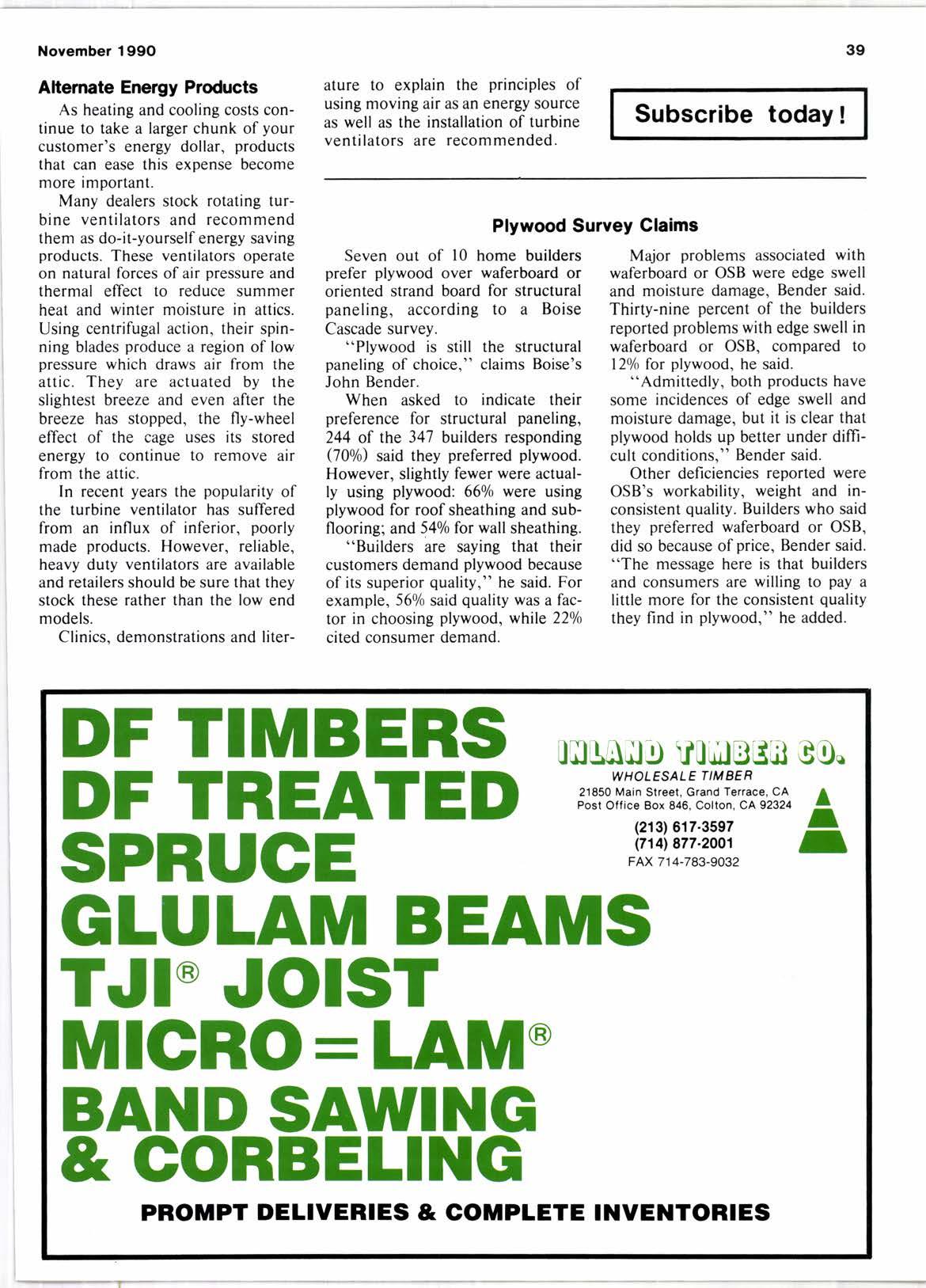
Major problems associated with waferboard or OSB were edge swell and moisture damage, Bender said. Thirty-nine percent of the builders reported problems with edge swell in waferboard or OSB, compared to l2o/o for plywood, he said.
"Admittedly, both products have some incidences of edge swell and moisture damage, but it is clear that plywood holds up better under difficult conditions," Bender said.
Other deficiencies reported were OSB's workability, weight and inconsistent quality. Builders who said they preferred waferboard or OSB, did so because ofprice, Bender said. "The message here is that builders and consumers are willing to pay a little more for the consistent quality they find in plywood," he added.
10 Inventory Control Tips
(1) Don't make theft too easy. Lock up anything easily pilfered.
(2) Use a gate guard. The big retailers have been using greeters for years. They are there not only to say "hello," but to check in packages and make sure returned goods aren't picked up on the way in the store.
(3) Check in any returned goods and require proofofpurchase. If no original invoice is available, hand write a return slip and research further. And get a reason why the items were returned.
(4) Label bulk merchandise bins, use bin labels in the store. Can your salesmen and loaders tell the difference in grades of plywood?
(5) Look for recurring discrepancies. If you are always short in a particular product and not in others, find out why.
(6) Do cycle counts. Specifically on high volume and/or high cost items. These have the greatest effect on total valuation.
(7) Keep it neat. It is easier to count and see errors in a well kept store. Pilferage is discouraged by having almost everything in its place.
(8) Keep your receiving timely. Enter goods received as soon as possible to keep from selling into negative quantities. This keeps quantities current and average cost calculations correct.
(9) Research all adjustments. Make sure any time an adjustment occurs, there is a good reason. Document as they occur.
(10)Put some trust in the quantity on hand your system reports. Those numbers were entered for a reason, and if the count is incorrect, find out why.
These suggestions were compiled by Dave Waddell, Southern Solution Center manager5 Dataline Corp., Atlanta, Ga.
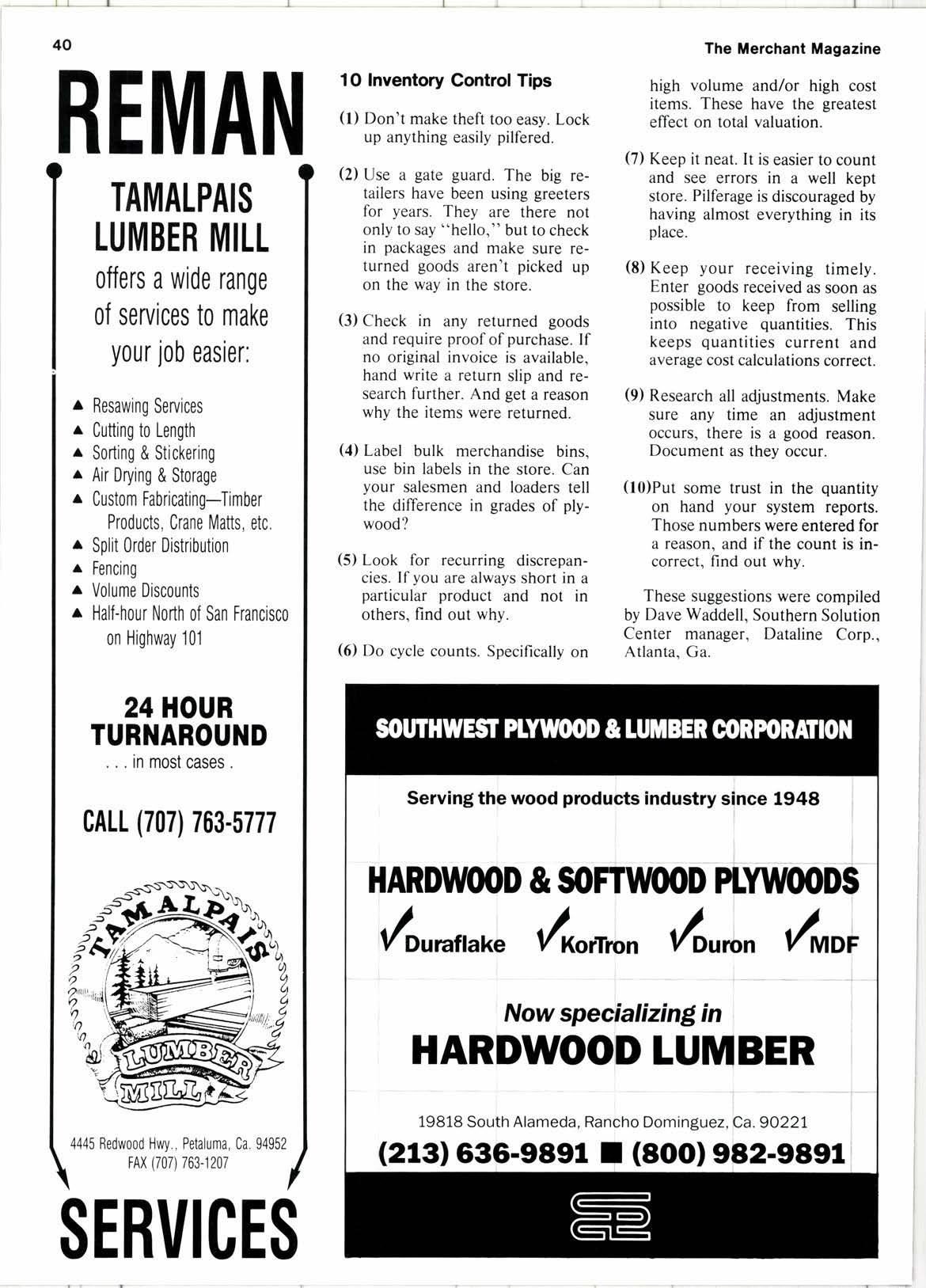
-"firREDW|!||0 Gfl0UE in Dimmock State Park was a 50th anniversary gift to James A. Jones, Foster Lumber Yards Inc., Vallelo, Ca., from his wife, 8etty. Officers and lriends from Hoo-Hoo International, the fraternity for the lumber industry, attended a dedication of the site on Highway 128 between Cloverdale and Fort Bragg, Ca. Ukiah Hoo-Hoo-Ettes assisted with the ceremonies.
Middle East & Asphalt
As a result of the Middle East crisis, prices for asphalt-related products such as roofing are climbing. In 12 weeks, the price of oil skyrocketed from $16.50 to near $35 a barrel at presstime.
Western Lumber Down 5olo
By the end of this year, lumber shipments from Western mills are projected to decline more than 50/o from 1989, setting this year's shipments from the 12-state Western Wood Region at 20. l2 billion board feet.
For 1991, shipments are forecast to drop another l.lolt lo 19.78 billion board fleet. This all assumes log supplies will be adequate. A Western Wood Products Association survey in early summer found those mills which did take log shortages into account were estimating average reductions in 1990 production at l0%.
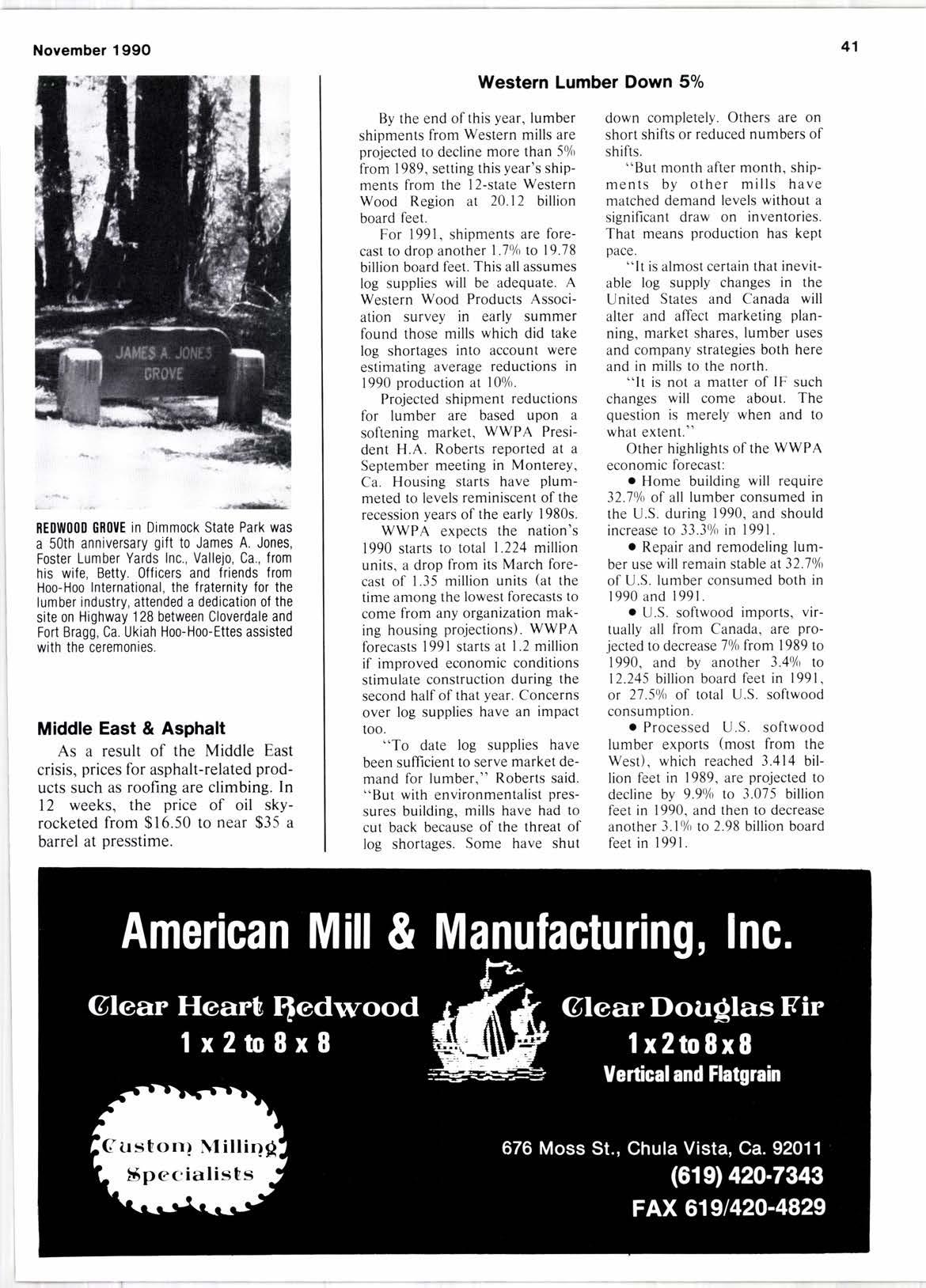
Projected shipment reductions for lumber are based upon a softening market, WWPA President H.A. Roberts reported at a September meeting in Monterey, Ca. Housing starts have plummeted to levels reminiscent o[the recession years of the early 1980s.
WWPA expects the nation's 1990 starts to total 1.224 million units, a drop from its March forecast of 1.35 million units (at the time among the lowest forecasts to come from any organization making housing projections). WWPA forecasts l99l starts at 1.2 million if improved economic conditions stimulate construction during the second halfofthat year. Concerns over log supplies have an impact too.
"To date log supplies have been sufficient to serve market demand for lumber." Roberts said. "But with environmentalist pressures building, mills have had to cut back because of the threat of log shortages. Some have shut down completely. Others are on short shifts or reduced numbers of shifts.
"But month after month, shipments by other mills have matched demand levels without a significant draw on inventories. That means production has kept pace.
"lt is almost certain that inevitable log supply changes in the United States and Canada will alter and affect marketing planning, market shares, lumber uses and company strategies both here and in mills to the north.
"lt is not a matter of lF such changes will come about. The question is merely when and to what extent."
Other highlights of the wwPA economic forecast: o Repair and remodeling lumber use will remain stable at 32.706 of U.S. lumber consumed both in 1990 and 1991. o U.S. softwood imports, virtually all lrom Canada, are projected to decrease 70lo from 1989 to 1990, and by another 3.40h to 12.245 billion board feet in 1991, or 27.50/o ol total U.S. softwood consumption.
. Home building will require 32.70/o of all lumber consumed in the U.S. during 1990, and should increase to 33.3% in 1991.
. Processed U.S. softwood lumber exports (most from the West), which reached 3.414 billion feet in 1989, are projected to decline by 9.90/o to 3.075 billion feet in 1990, and then to decrease another 3.1% to 2.98 billion board feet in 1991.
Forestry Genter Exhiblt
Interactive exhibits and displays for all ages tell the story of old growth forests in a special program at the World Forestry Center. Portland, Or.
Subtitled "treasure in transition." displays explain the four major components of old growth forests and their benefits to the world. Fairly well balanced between ecological and economic viewpoints, the exhibits were designed to recognize the significance of today's decisions for tomorrow's forests. A program of lectures and hikes was in conjunction with the May 5 through Nov. 5 display in Merlo Hall.
Benefts Outsell Low Price
Price is not the deciding factor for do-it-yourself shoppers in some categories, a Befter Homes & Gardens consumer panel discovered. When buying caulks and sealants.
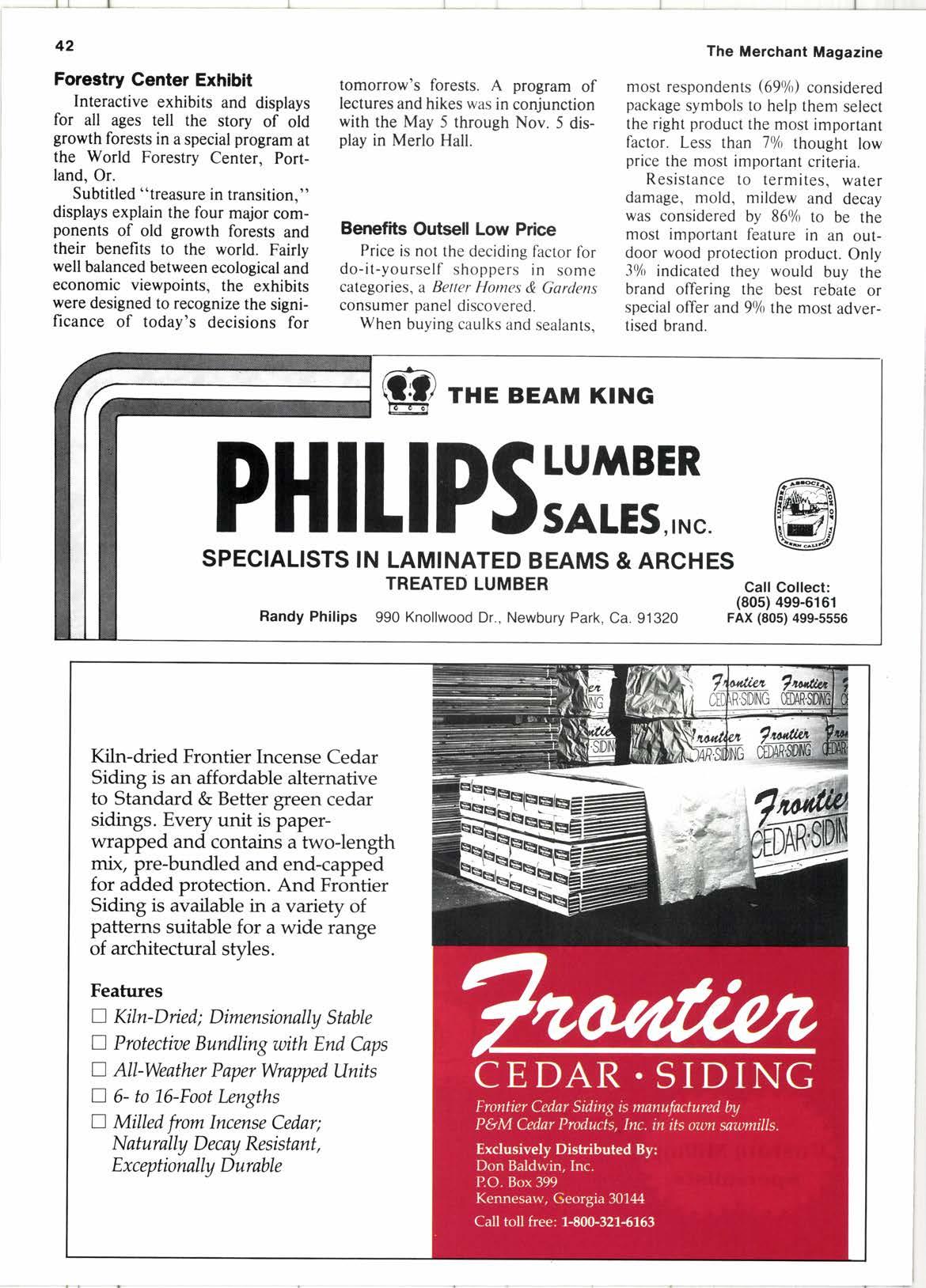
M
The Merchant Magazine most respondents (690/o) considered package symbols to help them select the right product the most important factor. Less than 7% thought low price the most important criteria.
Resistance to termites, water damage, mold, mildew and decay was considered by 86% to be the most important feature in an outdoor wood protection product. Only 3olo indicated they would buy the brand offering the best rebate or special offer and 90/o the most advertised brand.










